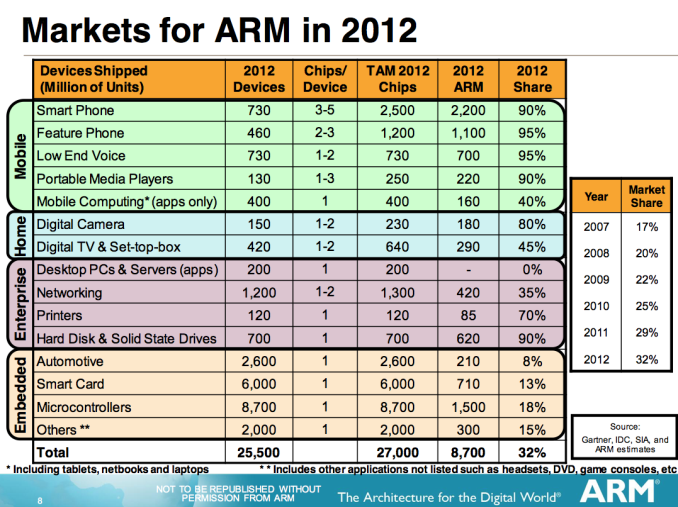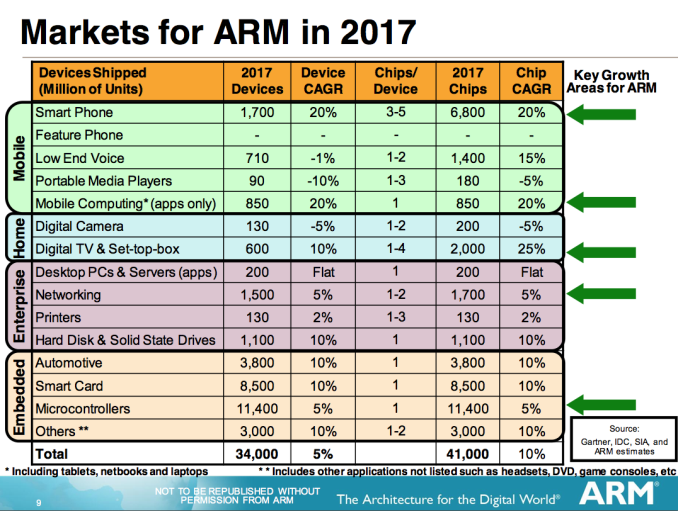The ARM Diaries, Part 1: How ARM’s Business Model Works
by Anand Lal Shimpi on June 28, 2013 12:06 AM ESTMarket Share
In 2012, ARM licensees shipped around 8.7 billion chips. Depending on the market segment, a single device can have anywhere from one to many ARM cores in it. Even looking within a smartphone you have multiple ARM cores not only within the apps processor but also inside the modem.
Although ARM has tremendous market share within the ultra mobile space (90%+), more than half of its shipments come from other segments. Enterprise, digital home, TVs, etc... are all expected to be drivers of growth for ARM in the coming years. By 2017 ARM expects its customers to be shipping roughly 41 billion chips that use ARM IP every year.
Final Words
Business models that leverage the scale and strength of a distributed production model are often very disruptive. ARM designs IP that can be implemented by fabless and fully integrated semiconductor companies very quickly, and at relatively low cost. No one member of the supply chain has to assume a significant amount of risk relative to others in the chain. It’s a far more democratic and partner centric approach to chip supply, which is one reason that it’s done so well.
ARM’s business allows for the creation and sustainability of several chip companies, which in turn keeps prices very low and prevents consolidation of power in any one firm. Although other factors (e.g. modem business, patent licensing) have lead to dominance in specific markets, ARM’s overall impact on the industry is one of promoting competition and keeping (silicon) prices low. ARM quite obviously enables what Qualcomm calls the Internet of things, where nearly everything is connected and computes.
It’s important to note that although our focus on ARM tends to be in the smartphone and tablet space, the majority of its licensed shipments come from other areas. It’s quite likely that ARM’s chances for future growth in terms of margin are in higher-end mobile SoCs, but competition from Intel in one segment surely won’t be the end of the world for ARM.
In the coming parts I’ll be taking a look at some of ARM’s newly announced microprocessor architectures such as the Cortex A12, A53 and A57. I’ll also be looking a little deeper into big.LITTLE and Mali graphics.












64 Comments
View All Comments
Spunjji - Friday, June 28, 2013 - link
I think you'll find that for the vast majority of users it probably is. I know that I am a distinct minority in spending more than ~£120 on a monitor for a desktop PC, and notebooks are now the dominant segment in PC sales where the cost of the display is going to be reduced compared to a desktop unit.name99 - Friday, June 28, 2013 - link
Look at an MBA. That's a far more representative type machine than a multi-screen desktop. That's what, $1200 or so, of which, what, $3..400 or so is Intel.No-one else is close. The display is, what, maybe $100 at the most. The storage is maybe $200 at the most (being charitable in both cases).
Lower end laptops which are still using Intel are cheaper and so the fraction is even higher.
madmilk - Friday, June 28, 2013 - link
In the PC world, the usual display is a $70 (eBay panel pricing, which is definitely an overestimate of BOM costs) 1366x768 display, or maybe a $140 1920x1080 display for nicer laptops and desktops. Even the rMBP 15 panel is only $300. In comparison, Core i5 processors start at over $200, and are very common in anything mid-range or above.lukarak - Friday, June 28, 2013 - link
All of the iOS devices are Arm based as well. Apple just designs their own processors based on the ARM instruction set, like Qualcomm with Scorpion and Krait, and unlike Samsung, NVIDIA or TI.Also, all WP are also ARM based.
aryonoco - Friday, June 28, 2013 - link
I know it's OT, but since others have mentioned, I thought I'd add my voice as well: I miss the podcast. I REALLY miss the podcast :-)Deepak Chamarthi - Friday, June 28, 2013 - link
Nice info , Thanks Anand. Indeed ARM like companies needs this type of dynamic model. Mobiles everywhere -:)dishayu - Friday, June 28, 2013 - link
So, who would the chosen 3 be? I can guess Qualcomm and Samsung. Which one's the 3rd? Apple? TI? nVidia?PEPCK - Friday, June 28, 2013 - link
Wouldn't be Qualcomm or Apple, as they only use the ARM architecture, preferring to build their own designs. TI is a partner for the A15, but is unlikely to be for future chips, due to their retreat from the high performance SoC business.dishayu - Friday, June 28, 2013 - link
Hmm... But then same logic should apply to Samsung and their Exynos chips as well.Ryan Smith - Friday, June 28, 2013 - link
Exynos uses standard ARM core designs though. Whereas Snapdragon and A6 (and beyond) are using custom core designs. There's a big difference between a custom chip using standard cores, and a chip using custom cores.